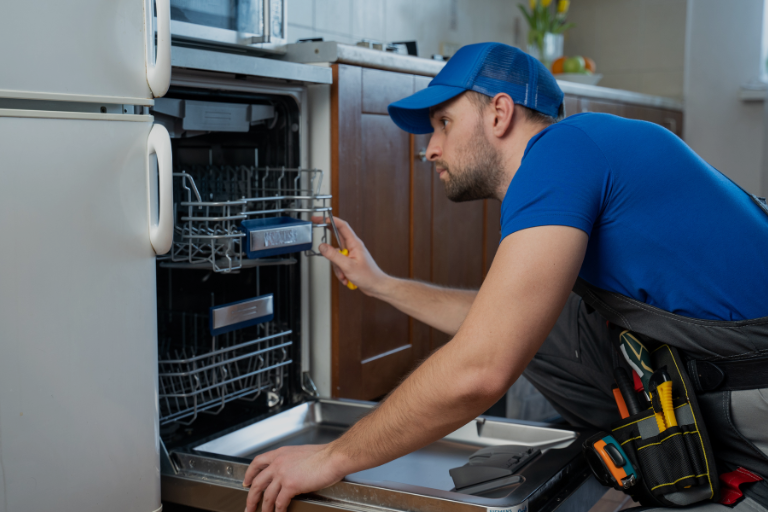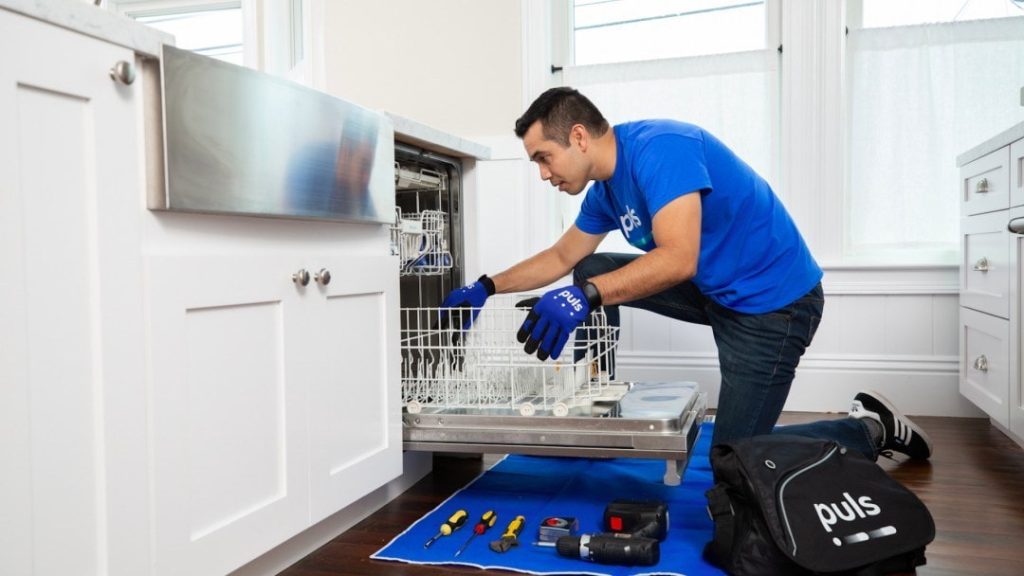Dishwasher not filling water – Possible causes and fixes

A dishwasher won’t fill water can be a major inconvenience, stalling your busy kitchen cleanup routine and delaying that much-needed wash cycle. Whether dealing with a loose water supply valve or a faulty water inlet valve, diagnosing the root cause is crucial to restoring your machine’s efficiency. In this blog, we’ll guide you through the primary reasons your dishwasher may not fill properly, how to identify each potential issue, and the step-by-step fixes to get your dishes sparkling again. With the right approach, you’ll prevent extended downtime, protect your appliance, and simplify daily chores.

Common Reasons for Dishwasher won’t fill Water
Even the most reliable dishwasher brand can experience problems with water intake over time. Understanding these frequent culprits sets the stage for quick solutions:
- Water Supply Line Issues: Kinked or blocked lines restrict water flow.
- Faulty Water Inlet Valve: A damaged valve impedes water entering the machine.
- Float Assembly Problems: A stuck or broken float switch halts water intake prematurely.
- Door Latch Malfunction: If the latch doesn’t lock, the dishwasher won’t engage the fill cycle.
By narrowing your focus to these common issues, you can quickly figure out whether your machine needs a simple tweak or more advanced repair.
Water Supply Line Issues
Check for Kinks and Blockages
Dishwashers rely on a continuous flow of water from your house plumbing. A bent, twisted, or crushed supply line can keep the machine from getting enough water:
- Examine the line connected to the dishwasher’s side or bottom.
- Gently straighten any visible loops or blockages.
- Look for signs of damage or pinhole leaks—like moisture or rust.
If your water lines suffer from advanced wear or the hose is severely crimped, replacing it might be the simplest fix.
Inspect the Connection
Check that you’ve got a secure link to the kitchen sink or dedicated supply line. A partially open or closed water supply valve can hamper the water flow. Ensuring the valve is fully open fosters correct water intake during each cycle.
Faulty Water Inlet Valve
Why the Inlet Valve Matters
The water inlet valve (sometimes called a dishwasher water valve) opens and closes to let water into the dishwasher tub at proper intervals. If this component clogs with food particles or experiences an electrical short, the machine can’t pull in water effectively.
Checking for Damages
- Remove the lower access panels to reach the valve.
- Check for rust, cracks, or visible damage on the valve.
- If you see a worn or clogged screen, rinse it with warm water.
Replacing a faulty water inlet valve is often necessary if the valve’s coil fails or if the screen is beyond simple cleaning. A skilled technician ensures correct reinstallation and alignment, maintaining full water flow.
Float Assembly Problems
The Role of the Float
Inside your dishwasher, a small float and float switch combine to control water levels. When water rises in the tub, the float lifts, signaling the switch to halt filling. If it’s jammed with food debris or physically broken, the dishwasher never receives the “fill” command or might fill only partially.
Signs of Float Assembly Issues
- The dishwasher stops mid-cycle with minimal or no water.
- The float seems stuck in its highest or lowest position.
- A quick jiggle or soapy water rinse can free a jammed float.
If the float or float assembly is truly compromised, you may need a new part to ensure correct water level detection.
Door Latch Malfunction
Why the Latch Matters
Modern dishwasher models rely on a properly sealed door to start filling water. If the door latch is broken or the door doesn’t close tightly, the dishwasher’s electronics sense it as open—preventing water flow for safety.
Confirming Latch Issues
- Close the door gently; if you can easily tug it open without pressing the release, suspect a latch fault.
- Look for misaligned hooks or a worn plastic actuator.
- Ensure the door’s angles line up with the dishwasher frame.
If you spot a misalignment, adjusting the latch assembly can fix it; for deeper mechanical damage, a complete part replacement might be necessary.

Troubleshooting Steps
Below are crucial steps for diagnosing a dishwasher that won’t fill with water, providing a straightforward guide:
Checking the Water Supply
- Locate the shut-off valve under the kitchen sink or basement feed line.
- Confirm it’s fully open and water flows at normal pressure.
- Inspect your home’s main power to the dishwasher: if it’s partially disconnected, the machine might fail to draw water.
Weak or irregular water supply leads to incomplete filling or no filling at all.
Inspecting the Water Inlet Valve
- Unplug the dishwasher and turn off the water.
- Remove the left panel or access panels at the bottom to reach the valve.
- Check for rust, leftover food matter, or slime around the valve screen. Rinse with warm water if needed.
- Use a multi-meter to test valve coil continuity. If readings show a short or infinite resistance, the valve coil likely needs replacing.
Note: Replacing the dishwasher water inlet valve is fairly straightforward, but always ensure you reattach each line securely to avert future leaks or incomplete fill cycles.
Examining the Float Assembly
- Locate the float—often at the tub’s front corner near the base.
- Move it gently up and down; it should move freely.
- Remove any plastic piece or food chunk preventing the float from rising or dropping.
- If you see cracks or heavy residue, consider a new float or thoroughly cleaning the old one.
A stuck float repeatedly signals the machine “water is full,” even when the tub is empty.
Testing the Door Latch
Dishwashers with electronic or mechanical door latches rely on a triggered internal switch to proceed with the wash and fill cycles.
- Close the door firmly. If you can easily pull it open, suspect a misaligned latch or bent metal catch.
- For mechanical latches, confirm the latch assembly shows no sign of wear.
- For electronic door switches, test continuity using a meter if you’re comfortable with it. Otherwise, call a technician.
Verifying the Drain Hose Position
Though mainly for draining, a poorly installed or kinked drain hose can sometimes block the normal water supply path if the dishwasher forcibly tries to rid leftover water mid-cycle. Ensure the hose behind the dishwasher is routed correctly and free from tangles or damage. If water can’t exit properly, the internal system may block new water intake, halting the fill process.
Preventing Future Water Filling Issues
Once you’ve fixed the current problem, adopting best practices preserves your dishwasher’s reliability.
Regular Maintenance Tips
- Clean the dishwasher filter monthly, removing leftover scraps or food residue.
- Wipe the interior with warm water and mild detergent to curtail bacteria buildup or blockages.
- Inspect the spray arm, door seal, and wash cycle performance at intervals to keep the machine at peak performance.
Avoiding Common Mistakes
- Overloading: Stuffing too many dishes can impede internal water flow, straining components that detect or fill water.
- Incorrect Detergent Usage: Over-sudsing or using the wrong type affects water flow.
- Ignoring Strange Noises: Loud or grinding sounds might signal the pump or motor is obstructed. Prompt attention can stop minor flaws from evolving into major breakdowns.
When to Call Toronto Refrigeration
Toronto Refrigeration prides itself on offering exceptional quality and reliable appliance repair services throughout the GTA. Our skilled technicians specialize in diagnosing water flow disruptions in dishwashers—ranging from a faulty water inlet valve to complex float assembly malfunctions. With a blend of advanced tools, decades of experience, and unwavering commitment to customer satisfaction, we handle any dishwasher hitch—be it excess water caused by a jammed float switch or an electrical fault in the machine’s control system. By entrusting your dishwasher to our licensed professionals, you’ll avoid guesswork, preserve your kitchen routine, and ensure your machine can clean dishes thoroughly every time.
Conclusion
A dishwasher that doesn’t fill with water can be a major inconvenience, disrupting everything from daily meal cleanup to your weekend gatherings. However, by thoroughly examining the water supply line, checking a faulty water inlet valve, or recalibrating the float assembly, you’ll often restore normal function without extensive hassle. Remaining proactive—through regular maintenance, prompt action against any unusual noises, and verifying crucial parts—helps avert repeat trouble. Should the problem persist or involve complex electronics, call on professional dishwasher experts like Toronto Refrigeration to protect your appliance and keep your kitchen running smoothly.